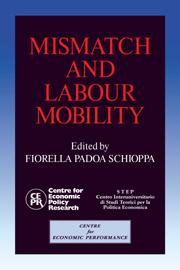Book contents
- Frontmatter
- Contents
- List of figures
- List of tables
- Preface
- Acknowledgements
- List of conference participants
- 1 A cross-country comparison of sectoral mismatch in the 1980s
- 2 Mismatch: a framework for thought
- Discussion
- 3 Match and mismatch on the German labour market
- Discussion
- 4 Mismatch in Japan
- Discussion
- 5 Mismatch and internal migration in Spain, 1962–86
- Discussion
- 6 Regional inequalities, migration and mismatch in Italy, 1960–86
- Discussion
- 7 Skill shortages and structural unemployment in Britain: a (mis)matching approach
- Discussion
- 8 Labour market tightness and the mismatch between demand and supply of less-educated young men in the United States in the 1980s
- Discussion
- 9 Skill mismatch, training systems and equilibrium unemployment: a comparative institutional analysis
- Discussion
- 10 Unemployment, vacancies and labour market programmes: Swedish evidence
- Discussion
- 11 Mismatch and labour mobility: some final remarks
- Index
5 - Mismatch and internal migration in Spain, 1962–86
Published online by Cambridge University Press: 05 October 2010
- Frontmatter
- Contents
- List of figures
- List of tables
- Preface
- Acknowledgements
- List of conference participants
- 1 A cross-country comparison of sectoral mismatch in the 1980s
- 2 Mismatch: a framework for thought
- Discussion
- 3 Match and mismatch on the German labour market
- Discussion
- 4 Mismatch in Japan
- Discussion
- 5 Mismatch and internal migration in Spain, 1962–86
- Discussion
- 6 Regional inequalities, migration and mismatch in Italy, 1960–86
- Discussion
- 7 Skill shortages and structural unemployment in Britain: a (mis)matching approach
- Discussion
- 8 Labour market tightness and the mismatch between demand and supply of less-educated young men in the United States in the 1980s
- Discussion
- 9 Skill mismatch, training systems and equilibrium unemployment: a comparative institutional analysis
- Discussion
- 10 Unemployment, vacancies and labour market programmes: Swedish evidence
- Discussion
- 11 Mismatch and labour mobility: some final remarks
- Index
Summary
Introduction
High European equilibrium unemployment has been the most important economic development in the last fifteen years, and macroeconomists have put a lot of effort into trying to explain it. The studies made for the first Chelwood Gate conference, collected in The Rise in Unemployment (Bean et al., 1986), analysed the roles of real wages and demand contraction in the increase of unemployment after 1973, but then the persistence of high unemployment over time became the main issue. This task was picked up by the second Chelwood Gate conference, which studied the role of capital constraints and insider wage-setting in generating persistence. Among the common findings across countries in the latter conference, as summarised by Drèze (1990), was that employment was consistently and significantly below the minimum of labour supply, classical and Keynesian employment.
Deficient matching between labour supply and demand became a natural suspect to explain this finding, and so the first steps are being taken, for example in Chapter 2 of this volume, to develop a theory of mismatch. It is also useful to provide empirical evidence on the various dimensions of mismatch, at the very least to find out which are more relevant for each country; this study is devoted to the latter task for the case of Spain.
Spain had very low unemployment – around 1 % – in the 1960s but then experienced a sustained increase in the 1970s and the first half of the 1980s, reaching a 21.5% rate in 1985, by far the highest in the OECD. Since then, the unemployment rate has drifted downwards, reaching 17.2% in 1989.
- Type
- Chapter
- Information
- Mismatch and Labour Mobility , pp. 182 - 234Publisher: Cambridge University PressPrint publication year: 1991
- 41
- Cited by



